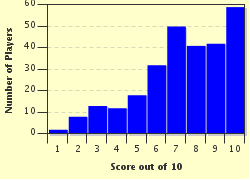Quiz Answer Key and Fun Facts
1. The Republic of South Sudan became Africa's newest country in 2011. In which part of the continent is it located?
2. Which of the following countries does NOT share a border with South Sudan?
3. The Abyei region, on the border with Sudan, was hotly disputed at the time of South Sudan's independence. What valuable commodity in the Abyei made it so desirable?
4. The Ilemi triangle is an area that has been claimed by Kenya, Ethiopia and Sudan (now transferred to South Sudan) since the start of the 20th century. At the time of South Sudanese independence, what country had de facto control of this area?
5. South Sudan is made up of ten states, which can be grouped into three historical regions. Which of these is NOT one of South Sudan's main regions?
6. The South Sudanese city of Juba lies on which major African river?
7. The terrain of South Sudan is mostly mountainous.
8. Which of the following statements best describes the seasonal variations in climate of South Sudan? This graph shows temperature (in red) and rainfall (in blue) for the South Sudanese city of Juba.
9. The highest point in South Sudan was formerly listed as the highest point in Sudan. What is the name of this mountain in the southeast of the country?
10. Salva Kiir Mayardit (pictured) was the first president of the Republic of South Sudan. As president, which of the following powers did he NOT have?
Source: Author
looney_tunes
This quiz was reviewed by FunTrivia editor
Pagiedamon before going online.
Any errors found in FunTrivia content are routinely corrected through our feedback system.

